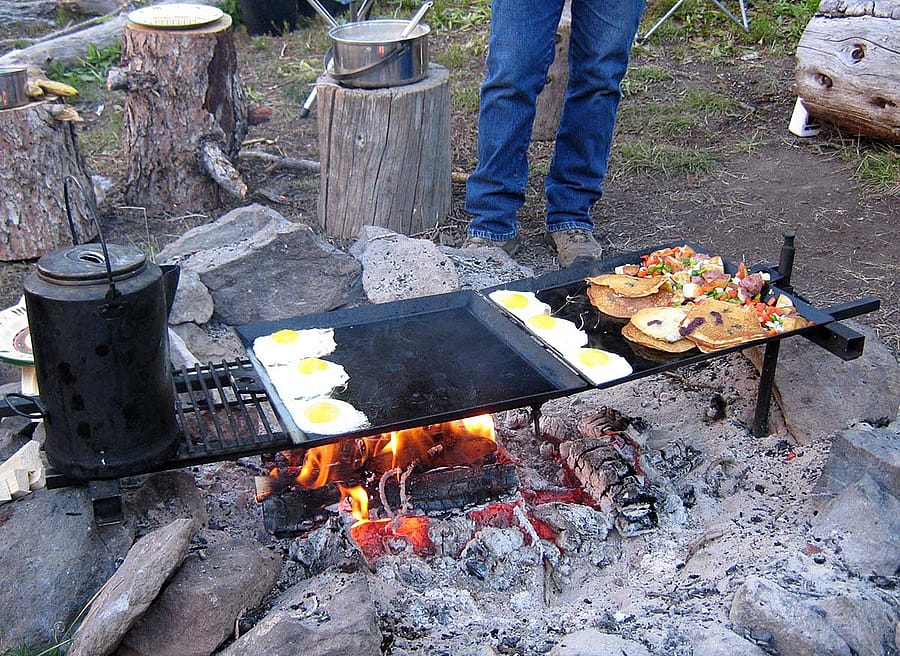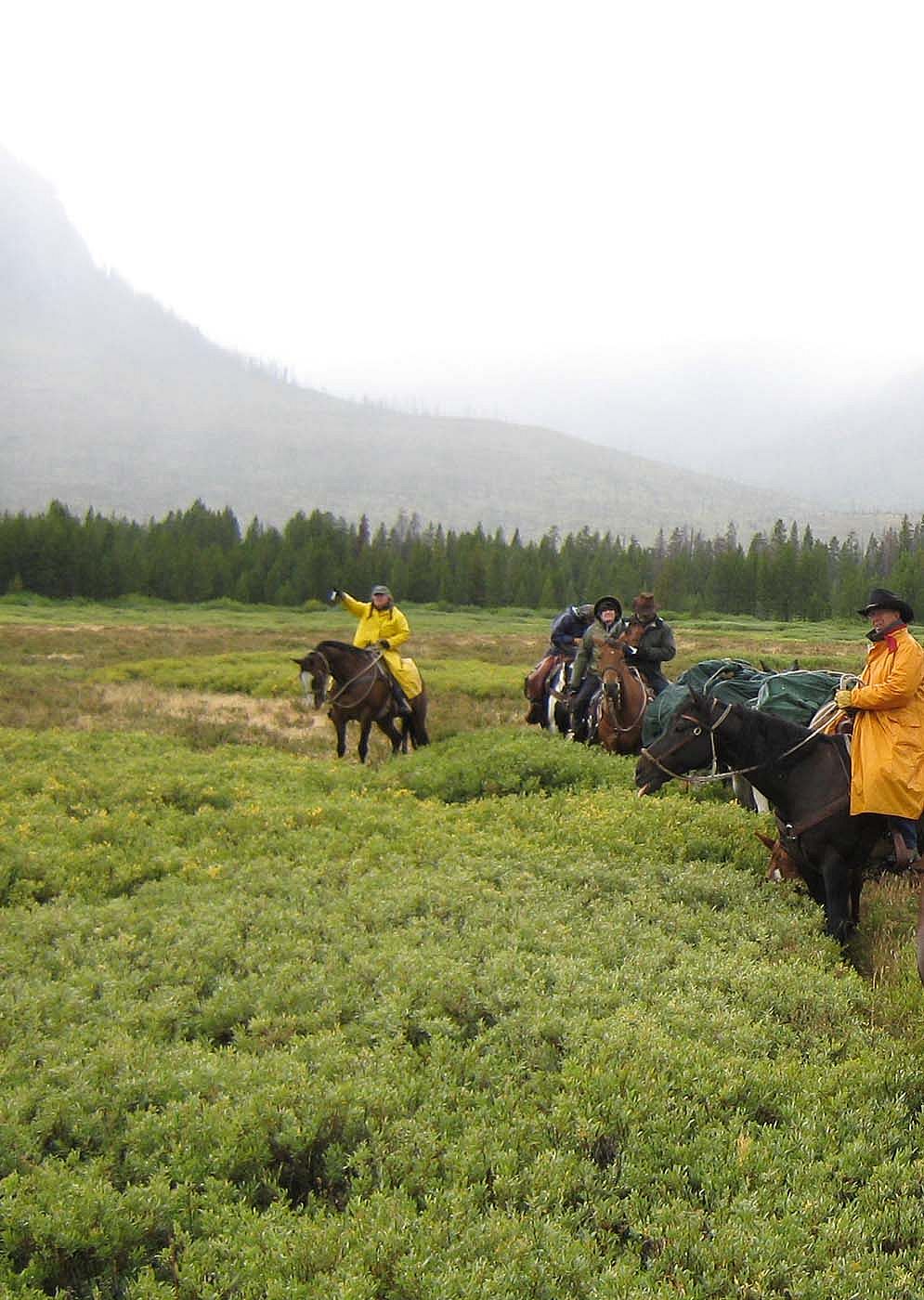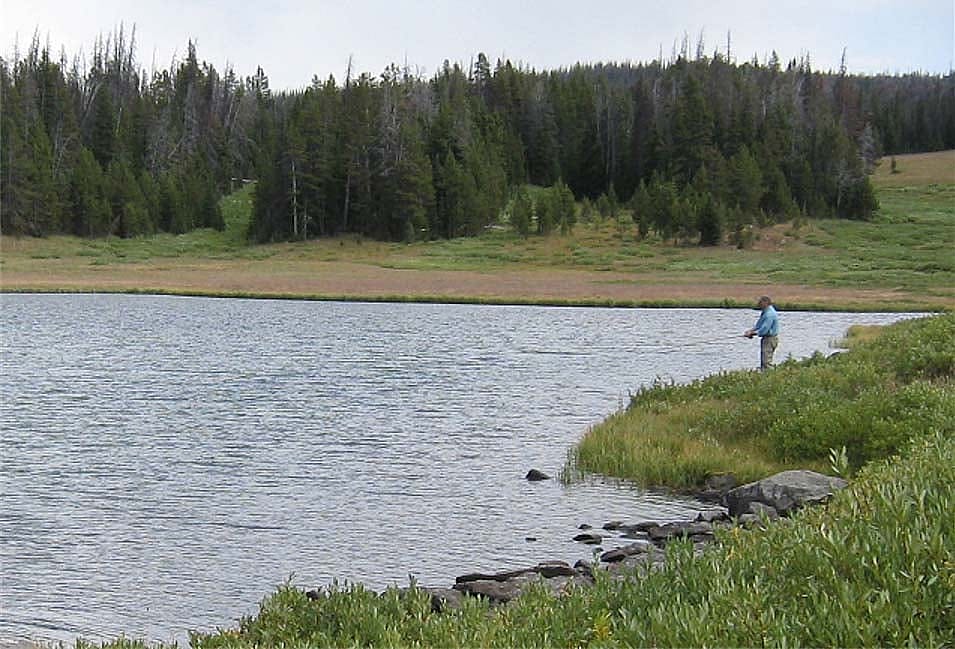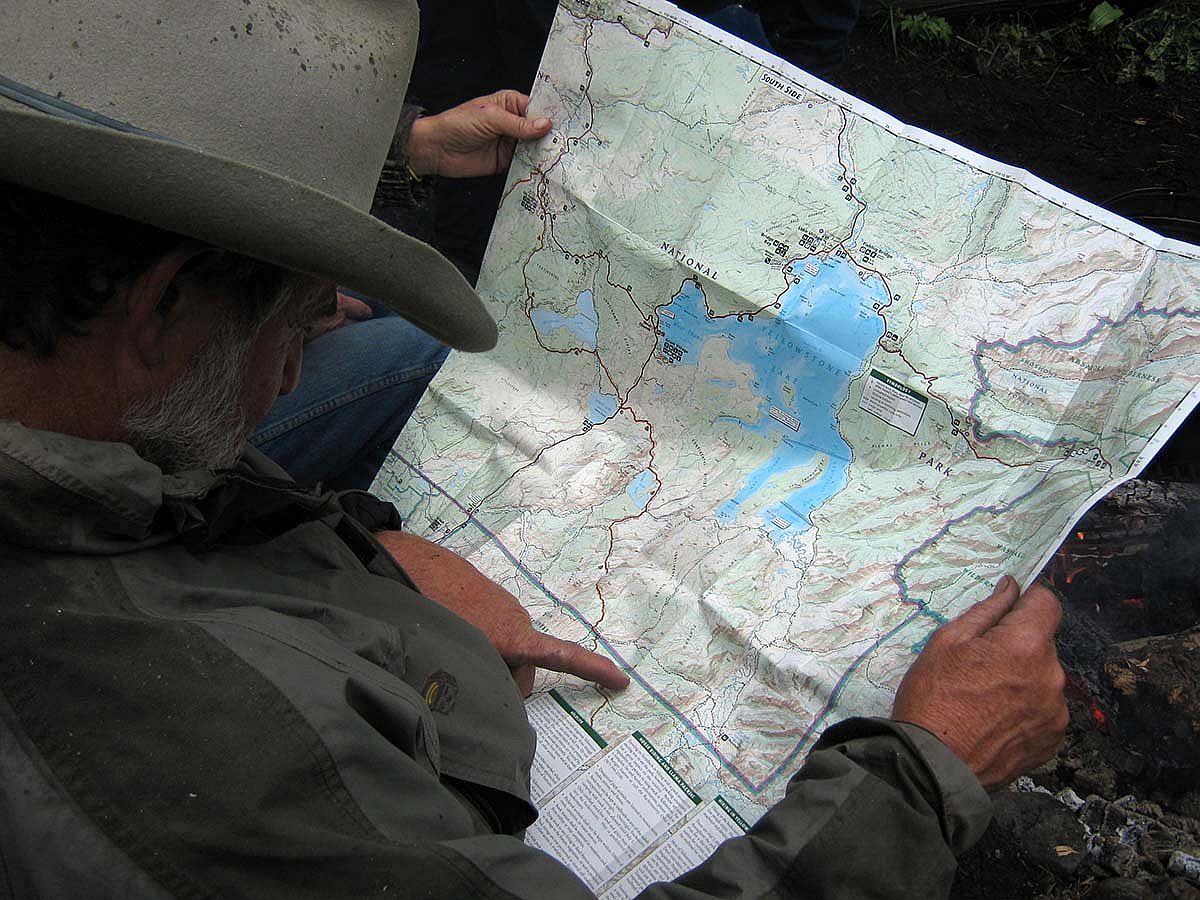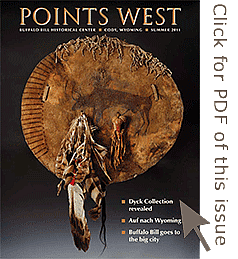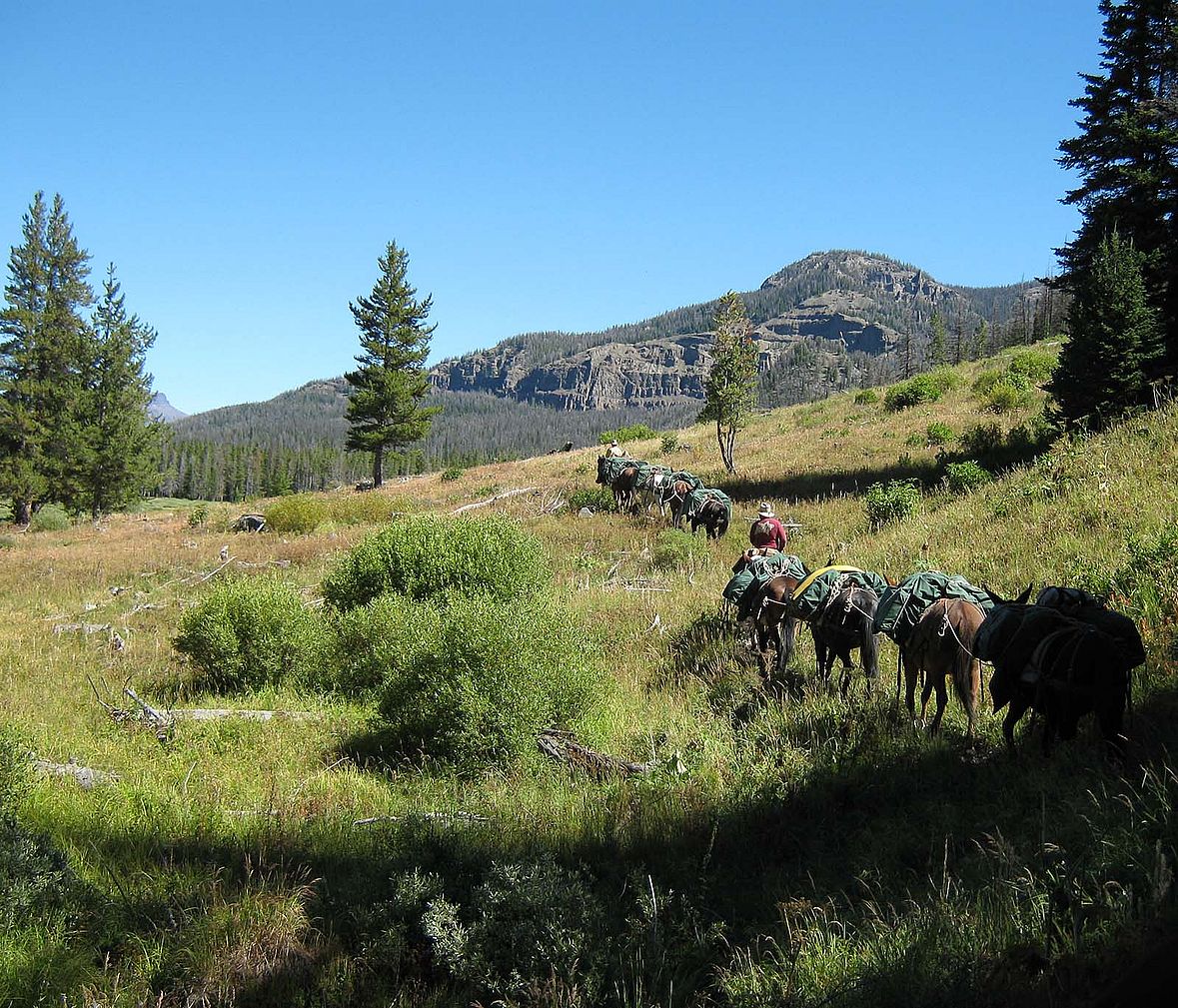
Into the Yellowstone Wilds – Points West Online
Originally published in Points West magazine
Summer 2011
Into the Yellowstone Wilds
By Jennifer McDonald, Former Program Manager, Draper Natural History Museum
Then-Natural History Program Manager Jennifer McDonald spent nine days in the summer of 2010 in the company of a dozen riders and two dozen horses and mules in the back country of Yellowstone National Park as part of a special Center natural history program. What follows is a look back at that trip from the log she kept through the journey.
On one of the last days of summer 2010, 13 people and 25 horses and mules set out on a nine-day trip across some of the most remote country in the lower forty-eight United States. Six guests—all friends and family of pack trip purchasers Marc and Jenny Gordon—were off to explore Yellowstone with Dr. Charles Preston, then-Curator of the Draper Natural History Museum as natural history expert. Sheep Mesa Outfitters provided adept packers, cooks, experienced riding and pack stock, and a deluxe camp. The Gordons had purchased the trip at Patrons Ball in September 2009, and, after a year’s wait, the trip was finally underway.
August 27, 2010
Our first camp at Basin Creek
I clicked on my flashlight to look at my watch: 6:10 a.m. Lying snug in my down sleeping bag, I stared at the pale, yellow-gray ceiling of my tent. I listened alertly, unsure if I had really heard what I thought I had. Nothing stirred except my own breath past the nylon of my bag. Then, yes, there it was again; a long, low howl; growing louder as it went. Another joined the first, then another, each on a different pitch. There was a brief silence and then the morning erupted with voices; rising and falling, as if each wolf were running up and down the scale. The pups’ voices sang higher than the rest, and it sounded as if they must be having quite the party out there in the meadow. The chorus lasted a few minutes, and then trailed off with high-pitched whines, low growls, and a few short barks. Once again, all I could hear was my own breath.
After breakfast, we watched the pack through our binoculars. For a long time, all we could see were a couple of adult wolves lying in the tall grass. Then, they got up and started to walk around, and before we knew it, we watched one wolf stalk and pounce on another in a display of dominance. The social interactions continued with lots of tail wagging, growling, and nuzzling. Then, they erupted into another chorus howl, a full wolf symphony, with their breath steaming in the cool morning air. After the group howl, they played and relaxed out in the meadow for another twenty minutes or so. Three of the pups playfully harassed one of the adults, grabbing and tugging on its ears and tail. Another pup chewed on a big bone, and a fifth was busy digging out a rodent burrow. It was a wild and timeless scene, played out just as it had been for countless generations.
It was only the first full day of the trip, and I could barely believe that we had a full week of adventure ahead. Late August is early fall in Yellowstone, and it is an exciting, dynamic, and beautiful time. The days are still warm, but the nights are frosty, and the biting insects of summer are all gone. Wolf packs are preparing to leave their rendezvous sites as pups have become big and strong enough to start traveling. Bears are in hyperphagia, a time of intense feeding that will help them prepare for the winter denning season. Elk are preparing for the rut—or breeding season—and we were all hopeful that we would be able to hear the first bugles of fall.
August 28, 1:40 p.m.
The trail from Basin Creek to Mariposa Creek
I squinted into the cold, damp breeze and thought back to how sunny and warm it had been at lunchtime. We had tied the horses and mules in the trees for a rest and wandered down to the creek. Basking in the sun on the rocks, we plowed through our sack lunches as if Sara, our gourmet camp chef, had not cooked us a tremendous breakfast of biscuits and gravy, fresh fruit, and sausage and eggs just a few hours before. But now I was glad for all of the calories! The trail had entered the Snake River Canyon and had grown steep. My horse found the trail to be no difficulty at all, but the dark clouds racing overhead, and the wind whistling through the burned forest made me both cold and nervous.
Just as it started to spit rain, I looked across the canyon and spotted a large dark shape on the rocks at the base of a cliff: a bear! It was probably about four-hundred yards away, but even so, the hump on its back clearly showed it was a grizzly. The bear appeared to be feeding on something; I guessed it must have been raspberries as they often grow on the sorts of talus slopes where he was. We paused long enough to untie our raingear from the backs of our saddles, put it on, and for most members of the group, to get a look at the bear. As we moved on again, he noticed us and spooked, moving away rapidly up the slope through the burned forest.
The horses’ shoes clicked on stone as we climbed rapidly up and around a rock outcrop. By the time we reached the top, the rain started to come down in earnest. Just ahead and below us was a green meadow next to the river and a small grove of mature spruce trees that had somehow escaped the 1988 fire. Wind drove the rain into our faces, and as soon as I tucked my chin into my warm collar, an elk bugled from below. In an instant, summer transformed to fall. Another bugle, then another bull answered. We scanned the meadow and opposite side of the canyon for a glimpse of the bulls, but they remained secretive and hidden.
Shortly, the trail dropped back into the more sheltered bottom of the canyon. We waited out the worst of the rain in the shelter of another surviving grove of spruce trees, our horses either standing as close to the trees as possible or turning their butts to the wind. Despite the uncomfortable weather, our spirits remained high. We were thrilled with the bear and elk, and were even more excited when one of the packers pulled out his flask of blackberry brandy from his saddle bag and passed it around. Eventually, the rain let up and with warm bellies and light hearts, we reined our horses back onto the trail and continued on toward camp.
August 29, 9:30 a.m.
Fishing on Mariposa Lake
With breakfast over, most everyone drifted up the trail to Mariposa Lake, where our outfitter, Ron, told us that large cutthroat trout lurked. The water was perfectly clear, and I could easily see the drop-off Ron told me about. “The big ones really like that deep hole right where the creek comes in,” he told me.
I laid my backpack down on the mossy, grassy bank, rigged up my rod, and tied a grasshopper fly on the end of my tippet. I stripped out line as I cast and dropped the hopper right in the middle of the pool where it landed with a satisfying “plop.” Out of the depths, a submarine fish rocketed toward my fly. When the fly disappeared into his mouth, I set the hook—fish on! He fought hard, and I found myself whooping with excitement as I played him and brought him in. It was a gorgeous, brightly colored male cutthroat, and though I didn’t have a tape measure, he was at least 18 inches long. I left him in the water while I unhooked him, and released him as he pushed out of my hands to swim back to his lair.
Soon, excited voices came from all around the lake as our group caught more fish. Anything that resembled a grasshopper or other large bug was fair game for the fish, and they hit eagerly again and again. Mariposa Lake is located at almost 9,000 feet elevation and is iced over for most of the year. Consequently, the trout have only a brief season in which to feed and grow. Today they were making the most of an early fall day. The fishing was so good it was almost more fun than we could stand! By early afternoon, however, the wind came up, and the clouds threatened rain, so it was time to head back down the trail to camp.
August 30, 12:10 p.m.
On the trail to the Yellowstone River
As we wound our way down Wolverine Creek, I suddenly realized that we had not seen anybody, besides the members of our own party, since we talked to the backcountry ranger at Heart Lake three days before. Just then, we caught our first glimpse of the expansive Yellowstone River Valley and the soaring peaks of the Trident and Hawks Rest. We were descending into the most remote region in the lower forty-eight United States. (Read more about the Thorofare region in this Points West Online post.)
Thorofare Creek joins the Yellowstone River not far south of where we would soon ford it. This area has been called the Thorofare since the 1830s when Jedediah Smith, Osborne Russell, and other fur trappers used the area and named it for the easy route it afforded through the rugged mountains. We emerged from the canyon and rode out onto the vast willow flats, surrounded by soaring peaks shrouded in clouds and mist on all sides. Everyone took pictures, and we all commented on how easy it was to imagine all of the people, over thousands of years, who had travelled through this wild and splendid place.
The Yellowstone River ford was at one of the more shallow places to cross, but the water still rose to our horses’ bellies, soaking our stirrups and prompting me to lift my feet and hike them up a bit so as not to get my boots wet. The current was smooth, but fast, and I kept my eyes focused on the far bank so as not to become dizzy. I admired the way the mules worked their way calmly across the river, and our entire string crossed without incident.
August 30, 11:30 p.m.
Camp at Mountain Creek
It was silent when I awoke and looked at my watch. Supposing the rain had quit and it would be dry enough to slip out of the tent for a midnight “bathroom” trip, I flipped on my flashlight and reached for the tent zipper. Even before I moved the zipper, the sagging tent walls gave away the night’s secret: snow. The cold rain had turned to the first snow of fall, and about four heavy, wet inches were clinging to my tent. Since I was outside anyway, I shook the tent and knocked off all the snow before crawling back into my snug, warm bag. As I drifted off to sleep, I wondered if the bears were starting to think about their dens yet.
August 31
A new day at Mountain Creek
When morning came, everyone was slow to get up, but the rewards for doing so were great. At the cook tent, a fire blazed, steaming coffee was waiting, and breakfast was nearly ready. Snowflakes sizzled as they hit the hot grill over the fire, and we all gathered round, hands wrapped around our mugs, hats snugged down over our heads. Eager for the pancakes, eggs, and bacon, we chattered, told stories, and grinned like a bunch of kids off at camp together.
That feeling of being kids at camp persisted all day. Four members of the group laughed most of the day away over a rousing game of Cribbage in the cook tent; some curled up with a good book next to the fire; some explored Mountain Creek and had a great time fishing for the micro-sized trout that were eager to take flies too big to even fit in their mouths. Even the herd of horses and mules had some excitement when a mother moose and her calf crossed the meadow near camp. The mules led the way in following their progress all the way across the meadow and into the woods.
By afternoon, sunshine returned; the snow was gone; and we were ready for the final leg of our trip the next day. We’d head up Mountain Creek and over Eagle Pass, crossing out of Yellowstone National Park and into the Shoshone National Forest.
September 3, 4:30 p.m.
Approaching the Eagle Creek Trailhead
We were almost to the trailhead and nearly at the end of the trip. Our two-night stay at Eagle Creek meadows had been fantastic. We had a sunny, mild, layover day perfect for fishing. The brook trout were as hungry for grasshoppers as the cutthroats had been at Mariposa Lake, and we could actually keep some brook trout. The fresh “brookies” made a delightful hors d’oeuvre, and as we savored the delicacy and finished off the last of the boxed wine we had carried on the trip, we reflected on the adventures of the past week.
As we turned our thoughts to the “real world” that awaited us back at work and home, each of us had a different favorite memory of the trip. For all of us, though, the magic was somehow related to being immersed in such a wild, remote, and beautiful part of the West. Yellowstone casts its spell on all who come here, and it was no different for us.
Just then, the trailhead came into view and for those last minutes, I focused on the feel of my horse’s rhythmic walk, the creak of saddle leather, and the connections I felt to each member of our group…and to the magical place called Yellowstone.
About the author
At the time this article was written, Jennifer McDonald was the Program Manager for the Draper Museum. She is a Certified Interpretive Guide, has a BA in Biology from Earlham College in Richmond, Indiana, and her areas of specialty include large mammals and birds. She called the Yellowstone area home from 1993–2011. In 2019, McDonald earned her Master of Divinity degree from Asbury Theological Seminary; she is now a pastor.
Post 323
Written By
Nancy McClure
Nancy now does Grants & Foundations Relations for the Center of the West's Development Department, but was formerly the Content Producer for the Center's Public Relations Department, where her work included writing and updating website content, publicizing events, copy editing, working with images, and producing the e-newsletter Western Wire. Her current job is seeking and applying for funding from government grants and private foundations. In her spare time, Nancy enjoys photography, reading, flower gardening, and playing the flute.

